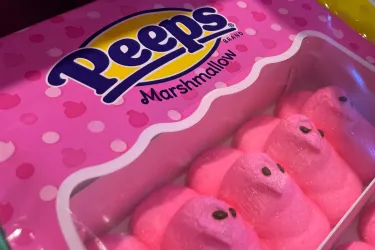What is Red Dye 3 and why has the US FDA banned it in food and drinks? Leave a comment
United States food regulators have banned Red Dye 3, a dye used in food, drinks and medicine after evidence found that it causes cancer in rats.
On Wednesday, the Food and Drug Administration (FDA) proscribed the dye based on a 2022 petition by consumer advocacy groups against its use, which had already been banned in cosmetics 35 years ago.
The FDA said it had taken the action as a “matter of law” after studies showed that the bright red dye had caused cancer in lab rats. The decision, the agency said, was rooted in a statute called the Delaney Clause, which requires the FDA to ban any additive that causes cancer in people or animals.
The dye has already been banned for food use in Europe, Australia and New Zealand, with the exception of certain kinds of Maraschino cherries that are used in cocktails or candied.
In 2011, a European Food Safety Authority study found no safety concerns due to the minimal exposure levels of the cherries containing erythrosine, known as E127 in Europe and Red 3 in the US.
What is Red dye 3?
Known as erythrosine, FD&C Red No. 3 or Red 3 is a petroleum-based colour additive used to give sweets and some cough syrups a cherry red colour.
In 1990, the FDA banned the use of the dye in cosmetics and non-oral medications, including pain relief creams, after a study showed that it caused cancer when it was eaten by rats.
In 2022, several consumer organisations and scientists petitioned the FDA to finally ban all remaining uses of Red 3. In November 2024, nearly two dozen Congress members sent a letter to the FDA officials demanding a ban on the dye.
But the decision taken by the organisation also comes amid US President-elect Donald Trump’s choice to lead the country’s health agency, Robert F. Kennedy Jr., calling for the ban on food additives and chemicals.
Yet, despite the backlash, Red 3 still appears in the ingredients of popular US snack foods and cakes, including Betty Crocker’s Red Decorating Icing and Brach’s Candy Corn sweets.
What has the FDA said?
In a statement announcing the decision on Wednesday, the FDA said it was “taking action that will remove the authorisation for the use of FD&C Red No. 3 in food and ingested drugs”.
“Evidence shows cancer in laboratory male rats exposed to high levels of FD&C Red No.3. Importantly, the way that FD&C Red No. 3 causes cancer in male rats does not occur in humans,” the statement added.
However, the FDA cited the Delaney Clause as the reason why the decision was taken to ban the dye despite finding that the way it spreads cancer in rats does not apply to humans.
The clause, which the FDA said was used in 2018 to ban certain synthetic flavours, “prohibits FDA authorisation of a food additive or colour additive if it has been found to induce cancer in humans or animals”.
The organisation said manufacturers that use the dye in food will have until January 15, 2027 to reformulate their products.
For drug makers, products must be reformulated by January 18, 2028, to comply with the ban.
What have manufacturers and consumer groups said about the ban?
The US National Confectioners Association, the leading trade organisation for the US confectionery industry, which is worth $48bn, said in a statement following Wednesday’s announcement that they will “continue to follow and comply with FDA’s guidance and safety standards”.
“Our consumers and everyone in the food industry want and expect a strong FDA, and a consistent, science-based national regulatory framework. We have been saying for years that FDA is the rightful national regulatory decision-maker and leader in food safety.”
The Center for Science in the Public Interest, which pushed the 2022 petition to ban Red 3, praised the decision by the FDA, saying the agency was finally “addressing a decades-long regulatory failure”.
However, the International Association of Color Manufacturers, which calls for the safe use of natural and synthetic colour additives, said while the FDA “remains steadfast in its commitment to upholding the highest safety standards for colour additives”, the amount of Red 3 consumed by rats to cause cancer needs to be considered.
“Science has advanced significantly in the past three decades, and it is now a well-accepted principle that test animals fed additives in high concentrations may produce increased incidences of tumours, but that does not necessarily indicate that the same effects will pertain to humans,” it said in a statement.
What other food additives could a Trump administration target?
Robert F. Kennedy Jr., who awaits his Senate confirmation to take up the position of Health and Human Services secretary, has already set his sights on banning other additives and foods.
In October, Kennedy called for cereal companies to “take the dyes out of their foods”.
But his position on seed oils, which include canola, soy and sunflower oil has come under significant criticism from nutritionists and scientists.
Kennedy claimed that Americans had been “unknowingly poisoned” by seed oils, with beef tallow a better and healthier option.
However, Christopher Gardner, a professor of medicine at Stanford University, told The New York Times that decades of research had proven that seed oils were linked to better health.
He added that suggesting otherwise “just undermines the science”.
- If you are looking to order local products, handcraft, custom clothes, various books, handmade arts, furniture’s, food spices etc. please, visit our web page at www.ethio-amazon.com. Or send us your request at email contact@ethio-amazon.com you can also contact us on WhatsApp at +2519-44-36-97-53
Additionally, if you would be interested to socialize and looking for a new friend around the world, for future partnership… visit our web page at www.contactyourlifepartner.com
We believed that love can happen anytime, anywhere in a world filled with endless possibilities… for more information contact us at Email contact@ethio-amazon.com or Call us at +2519-44-36-97-53 (WhatsApp),
+ 6676539901 (international)Source (Al jazeera News)

